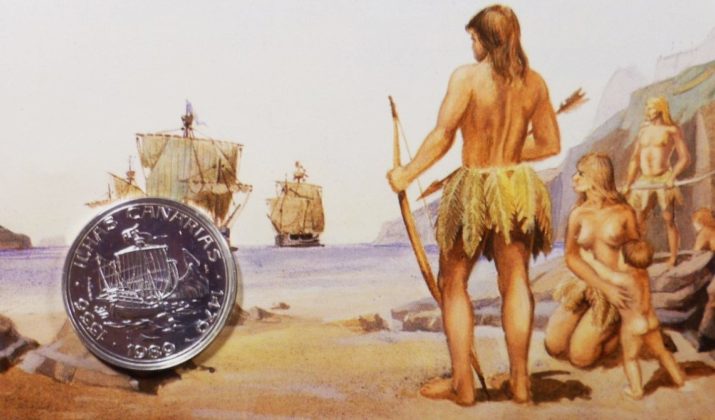This time pier2 takes us to the Canary Islands, to Tenerife to be precise, to discover a very special coin!

Once again, the approach of a modern 20th century coin allows me to discover the history of a part of the world, and to give you a bit of background reading.
On the obverse of the 1989 Portuguese 100 escudo commemorative coin, on either side of the Portuguese coat of arms are “a Guanche man and woman”, the pre-European inhabitants of the Canary Islands at the time of the Portuguese discovery in the 14th century. Just below, a ribbon bearing a sentence in Latin: “HOMINES SYLVESTRES DE INSULA CANARIA” which literally translates as: “The savage men of the Canary Islands’.
On the reverse, a caravel-type ship with a square sail, facing the Canary Islands.
– On the left is 1336, the date of the first discovery by Europeans. The Portuguese explored the Canary Islands for four months in 1341, amid the violence of the volcanoes.
– Right: 1479, date of the Treaty of Alcáçovas for the islands, which were eventually awarded to Spain.
Back to the subject at hand: the Guanches are an ethnic group and indigenous people of the Canary Islands. The Spanish term “Guanches” is thought to be a distortion by the Spanish of “Guanchinet”, an indigenous term meaning man (Guan) from Tenerife (Chinet).
The Guanches would therefore only be the aborigines of the island of Tenerife, but the term was later extended to all the indigenous populations of the Canary archipelago. Unfortunately, a significant proportion of the Guanche population perished while resisting the Spanish conquest of the archipelago, and most of them were forced to embrace the Catholic faith, some marrying into the conquerors’ ranks. Several thousand Guanches were enslaved and deported to Spanish farms. Rather than use the Guanches in the Canary mills, the Spanish preferred to move them off the island in order to cut them off from their environment and thus reduce the number of revolts.





